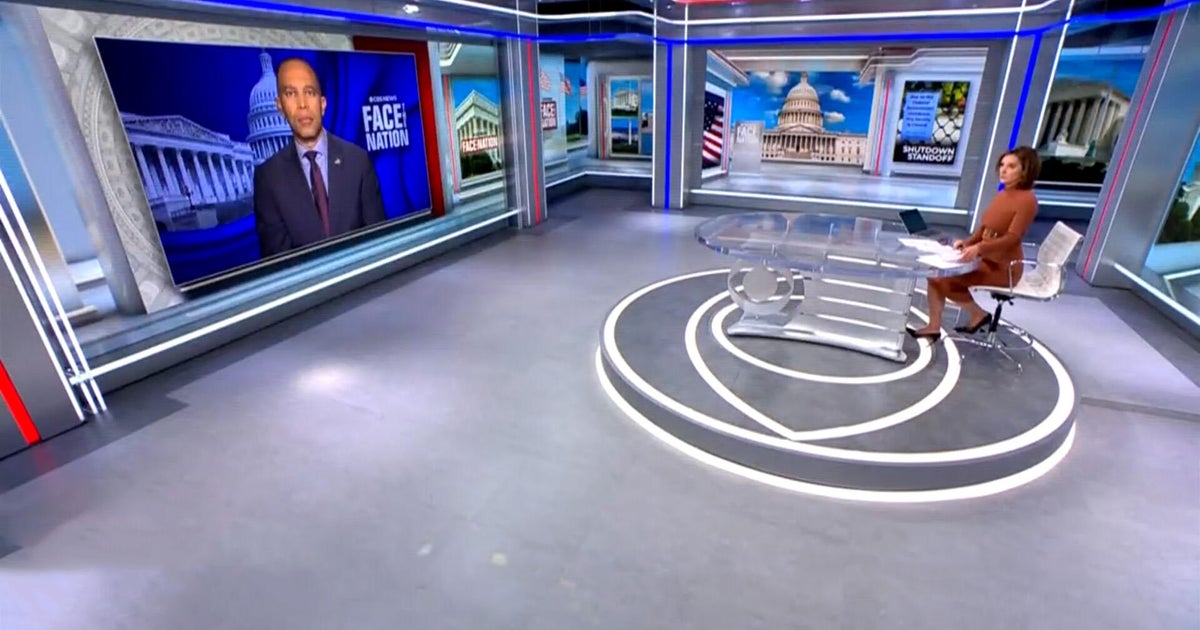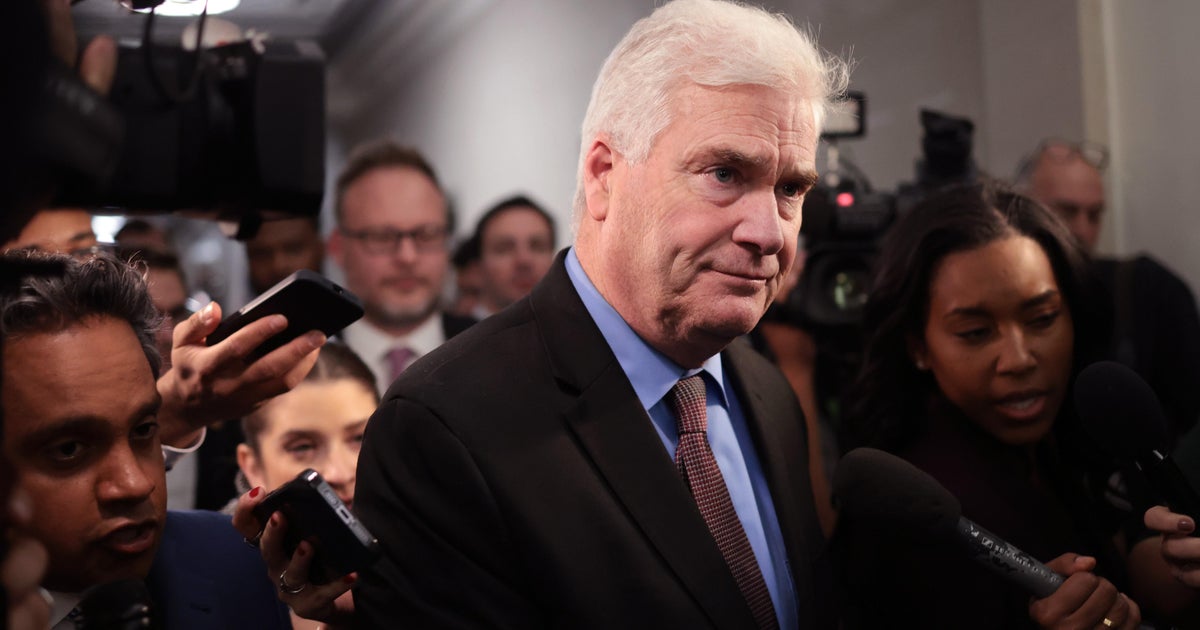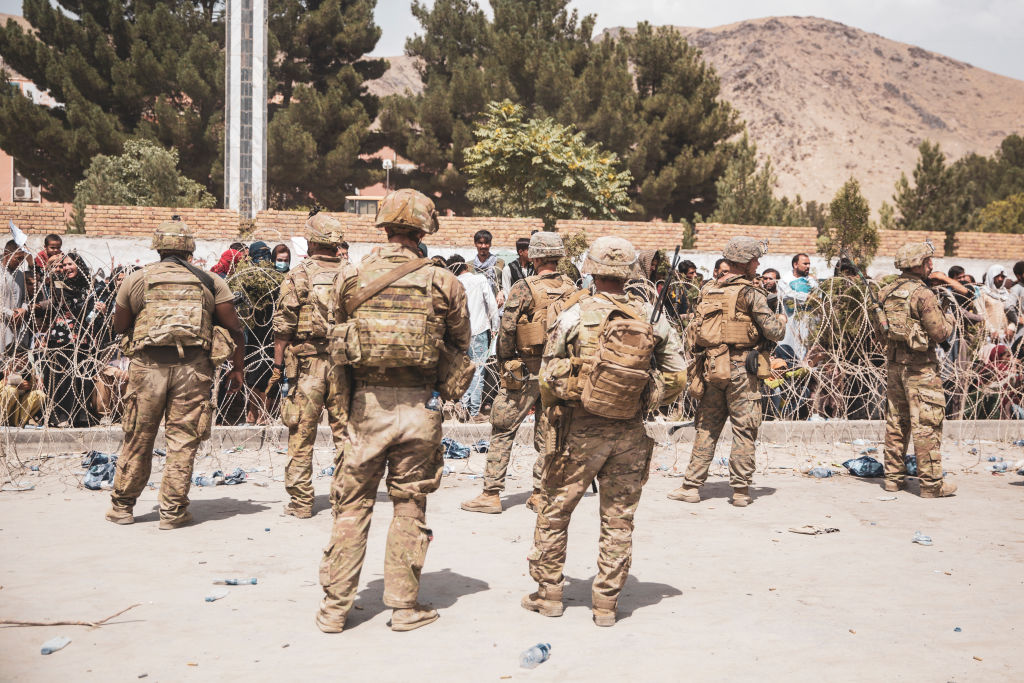Military affairs author Wes Morgan on U.S. military in Afghanistan's Pech Valley - "Intelligence Matters"
In this episode of Intelligence Matters, Wes Morgan, military affairs reporter and author of The Hardest Place: The American Military Adrift in Afghanistan's Pech Valley joins Michael Morell to discuss his time as an embedded reporter with U.S. troops in Afghanistan's Pech Valley. Morgan describes the Pech as a microcosm of the overall war in Afghanistan, and explains why a lack of information-sharing led to repeated mistakes. Morgan details the tensions between the counterterrorism and counterinsurgency missions as well as the challenges posed by the Afghan terrain.
- U.S. troops not learning from the mistakes of previous units: "One thing that I found was that there was a lot of optimism early on. When Americans showed up, people really were very hopeful about what they would bring and they really gave a lot of leeway for mistakes. U.S. soldiers might shoot the wrong person by accident, detain the wrong person. Initially, there was a lot of benefit of the doubt given. But over time, as more units rotated in and inevitably made the same mistakes over and over and over again, it accumulated."
- Counterterrorism and counterinsurgency missions in conflict with one another: "Often, you'll see these counterterrorism and counterinsurgency missions really in conflict with one another. You'll see the effects of a night raid where SEALs or rangers come in and kill a bunch of people in the night, even if they get their guy, they're killing a lot of people in a local community. And the infantry platoon that lives there has to deal with the mess in the morning."
- Challenges posed by terrain to U.S. troops in Afghanistan: "It changed over the course of the war, but some of the things that were constant were just the very great disadvantages and problems posed by the terrain. You're going to be shot at from across a stream, from another opposite ridge line, and you're not going to be able to get up there. So there's a lot of long distance firefights and a lot of the use of artillery and airstrikes and mortars to respond to enemy attacks. It was really a war of firepower. It was not so much a war of crawling along on the valley floor, waiting to be struck by an IED."
Download, rate and subscribe here: iTunes, Spotify and Stitcher.
INTELLIGENCE MATTERS: Wes Morgan transcript
PRODUCER: Paulina Smolinski
MICHAEL MORELL: I want to start by congratulating you on your book, The Hardest Place: The American Military Adrift in Afghanistan's Pech Valley. I must tell you and my listeners that I found it extraordinarily well written, extraordinarily well researched, absolutely fascinating, a page turner from that perspective, but also very sobering and I have to say frustrating. I hope we'll be able to highlight those last two feelings, sobering and frustrating, for our listeners as we as we talk about the book. But I start with congratulations.
WES MORGAN: Thanks very much for reading it. I'm glad that it resonated.
MICHAEL MORELL: Why did you write the book and why did you focus it on one location in Afghanistan?
WES MORGAN: About a decade ago, I was spending time as a freelance journalist, kind of roving around Afghanistan's south and east during President Obama's surges. I would go from battalion to battalion visiting US and British infantry units that were essentially in the toughest fighting that I could find. I was covering infantry operations as an embedded reporter. I wanted to see the places were units were having a hard time. So I would go to everywhere from the Brits in Sangin and Helmand to U.S. troops in the Arghandab Valley in Kandahar.
On the second one of these trips that I made in 2010, I found myself in the Pech Valley. It really just got me hooked. It felt very different from other places in Afghanistan that I'd been. That was just sort of the original root of my interest, this place seems so different. It's so beautiful. There are these forests. Yet it also seems like it's settled into this stalemate. US forces and the Taliban, they've been here forever. They're duking it out with just unbelievable amounts of ordnance. I've never seen so much artillery fired in probably all of the other embeds I've ever done know cumulatively. And yet it wasn't obvious how things had gotten this way.
You'd visit these little fire bases along the Pech Valley floor and the company commander there would not be able to tell you when or why that outpost had been established. So the original impetus for looking into the Pech, which I started to do actually while I was still a college student for a senior thesis, was just to figure out why these outposts had gotten there, what the back story was on each of them. The more I looked into it, the more it became clear that there were a lot of the bigger threads of the war, not all of them by any means but a lot of them, appeared in microcosm in the Pech.
In particular, this overarching tension between the counterinsurgency and nation building mission on the one hand and the counterterrorism mission on the other hand, which was always very present in a very visible way in the Pech and its surroundings in a way that it wasn't in a place like Sangin or the Arghandab in the Taliban heartland where there were not al-Qaida operatives running around.
MICHAEL MORELL: So when you when you first went there, you were quite young, right?
WES MORGAN: I would have been twenty-two, I think.
MICHAEL MORELL: So how does a 22 year old get into an embed?
WES MORGAN: At the height of these wars, the US military in particular, and our allies to a lesser extent, were very generous with the media, with their embedding program. It was a great way for freelancers to get started. So I was spending my summers during college through a weird opportunity I'd had after my freshman year, starting with Iraq, just going and taking advantage of this program. There was kind of low overhead. You just had to show the units that you knew what you were doing and weren't a total idiot. And they would be pretty welcoming of you in covering their operations.
MICHAEL MORELL: Can you give us a sense of the general location of the valley? Where are we talking about particularly in relation to Kabul and to Pakistan?
WES MORGAN: We're looking at a place that's about a hundred miles northeast of Kabul. It's a river valley that empties from Nuristan province, which is very, very high up in the mountains with kind of glacial lakes. It empties from Nuristan down into Kunar Province, which is a border province with Pakistan. The provincial capital or provincial seat of Kunar is a small city called Asadabad. And Asadabad sits at the junction of the Pech river with the larger Kunar River. And so the Pesh itself, just as it joins the Kunar, it is also joined by smaller tributaries, some of them very infamous, like the Korengal Valley, the Waygal Valley, places where really tragic episodes of the war have played out. That's basically the location of it.
One of the things that's unusual about it is Kunar and Nuristan are home to one of the last real forest complexes in Afghanistan. And that's something that's affected the war in a lot of ways, is these big, thick conifer forests full of pines, cedar, and firs. They have both made physically operating up there very difficult and dangerous because you can imagine it's difficult to find places to land helicopters, and it presents obstacles for aerial surveillance. And also in other kind of more subtle ways, as there's actually a timber trade up there that has played an outsized role in the US involvement.
MICHAEL MORELL: I wanted to get a sense from you of the geography and the terrain. What does that look like?
WES MORGAN: It's very jagged. Anywhere in the Afghan east. You'll see great elevation. Things are very high up. But in Kunar, you see just everything is very sharp, sharp angles, sharp slopes, in comparison to kind of the more rolling plateaus you might see in some other parts of the east, farther south along the border. There are very thin valley floors that are cultivated and this very lush green from the corn that people grow there. That's where a lot of the towns are. But then there are also towns that are really just clinging to the mountainside in this very precarious looking way. As you go farther up the slopes, you'll see as you go up, you pass through dry, arid parts of the mountainside and then you get up to these huge forests with their enormous trees that have such a big role in the war.
MICHAEL MORELL: And what's the altitude of the peaks?
WES MORGAN: They rise up to ten, eleven, twelve thousand feet. The Pech valley floor is at three thousand feet. So not actually that high up. You don't feel out of breath when you first show up in the Pech where you might in some of the parts of the Afghan east. They rise very steeply and sharply up from there to these much taller mountains that you'll see snow on even in the spring and summer.
MICHAEL MORELL: When did U.S. troops first show up in the valley and what took them there?
WES MORGAN: They showed up in 2002, very early on in the war. And this was something that was not obvious to me when I started researching and writing. I didn't know when the first base at Asadabad had been established. I didn't know when the first U.S. troops had ventured into the valley because a lot of that had been done by special operations forces and the CIA, by units that were operating outside what embedded reporters could see who were covering the conventional infantry war. But it turns out, as I kind of rewound this tape and talked to more and more people and had them introduce me to the people before them and so on, that this all comes back to the hunt for bin Laden and the US military and the intelligence community trying to figure out where bin Laden had gone after his December 21 escape from US bombing at Tora Bora.
We know in retrospect that he did, in fact, go to Kunar Province, where the Pech is located. But this wasn't known at the time. The military and intelligence community suspected this and they followed him up there and they came closer than probably they really knew not to actually getting him, but to being a couple of months behind him, to finding someone that could have told them where he'd gone. At the time, it was one of a number of places that they thought he might have gone. And so these little teams, reconnaissance teams of special operators and intelligence operatives, were spreading out to the four winds, setting up little fire bases from which they could drive out in pickup trucks and ATVs and talk to people and follow up on tips, essentially looking for Arabs.
MICHAEL MORELL: Why did we stay for as long as we did? And in asking that question, I have in the back of my mind what you heard from Lieutenant Colonel Joe Ryan, who was the battalion commander in the region, telling you in 2002 essentially that he had no idea why he and his men were there.
WES MORGAN: Yes. Colonel Ryan was the battalion commander in 101st Airborne in 2010 when I visited during the surge. He's actually back in Afghanistan now, as a one star general. He's been selected for promotion to a two star general, I think, on his eighth Afghanistan deployment. And he's a guy who recurs throughout the book because he's one of these few people who just kind of, by the luck of the draw, kept seeing the war in the Pech at different stages. So he had actually been there in 2003, during a very large Joint Special Operations Command operation up in the Pech. Then he just happened to return there as a battalion commander in 2010. So he was able to hint at the answer to that question of how did the mission evolve, because he was one of the few people who had seen an earlier point in the evolution.
But a lot of what you see is not so much a big decision being made in Washington or Kabul that decides the course of 'we're going to be in this valley pursuing this mission until it's done.' You see different units rotating through and different tribes of the US military taking responsibility for it in succession and each one of them kind of using it for their own purposes of trying to accomplish different things there, eventually being pulled out and some other unit being left holding the bag to figure out what to do with it next.
So you see these little incremental changes along the way during every unit rotation, whether that's six month tours for these Green Berets and Marines who were there early on to 15 and 16 month tours for some of the infantry units that were there at the height of things. Things would evolve during the course of these deployments. Then a new unit would come in and that new unit would just inherit what they inherited. And they wouldn't have much of an idea of how that compared to what things had looked like a year earlier or two years earlier, let alone five years earlier.
MICHAEL MORELL: What was the fighting like in the valley? What was it like to be a soldier there?
WES MORGAN: It changed over the course of the war, but some of the things that were constant were just the very great disadvantages and problems posed by the terrain. You're going to be shot at from across a stream, from another opposite ridge line, and you're not going to be able to get up there. So there's a lot of long distance firefights and a lot of the use of artillery and airstrikes and mortars to respond to enemy attacks.
It was really a war of firepower. It was not so much a war of crawling along on the valley floor, waiting to be struck by an IED. Which is a way of I think a lot of veterans would characterize their experiences in other parts of Afghanistan, particularly the South. But it was a war that I think for a lot of guys was very satisfying and thrilling in comparison to other places that they wound up fighting or had fought earlier in Iraq and Afghanistan just because of the amount of firepower involved and the fact that you really were shooting back at your enemy all the time.
MICHAEL MORELL: One of the things that struck me when I read the book was the routine nature of that. It happened all the time. You came to expect at some point during the day to be fired upon.
WES MORGAN: Yeah, absolutely. I open the book with a scene in 2010, at little fire base at the mouth of the Korengal Valley, where it joins the Pech called Combat Outpost Michigan. And Michigan was an interesting place because at the time the military would call it the most kinetic meaning, the most frequently attacked outpost in all of eastern Afghanistan. It just was sucking down these attacks three or four times a day every day. They could last five minutes, they could last forty five minutes. And they would involve everything from volleys of RPGs from the mountains to recoilless rifles, which I associated with Korea and Vietnam and didn't really know they were in use in the war until they started hitting this outpost that I was visiting. To mortars, to an old Soviet automatic grenade launcher. Then US troops would fire back with the stuff they had on hand. Their crew served weapons in the outpost, in the mortars. And then there was this cascade of artillery and then satellite guided bombs that would start coming in this very routine fashion.
To the troops at Combat Outpost Michigan, the way they behaved in it, it almost felt like they were talking about weather, 'this attack is light, this attacks heavy. Do you want to go outside in that one.' As though it were rain or hail or something. It was very striking to me that by that point in the war, the routine had evolved to such a degree that you kind of wondered who was really getting hurt on either side. I mean, it wasn't safe. I mean, there were guys wounded on the outpost just during my brief stay. They had lost a mechanic killed in an attack not that long before, but they really were very heavily fortified and battened down compared to what I would come to learn that outpost had looked like a few years earlier. And by the same token, the enemy up in the hills, they've been at this a long time. They know exactly how long, how many minutes and how many seconds it's going to be before the mortar shells start falling and then the Howitzer shells and then the JDAM bombs. So you really got the sense that who was being hurt most at this point in the war was just the people who lived there who happen to live near the US outposts and would get caught in the crossfire.
MICHAEL MORELL: And you were there for some of these firefights, correct?
WES MORGAN: Yeah, for sure.
MICHAEL MORELL: So what was it like for you as a journalist?
WES MORGAN: I mean, it was fascinating. It was very different from-- I've become very accustomed to just going out on patrols, walking around, driving around and the real threat being IEDs. And so that was something I was pretty used to at that point. Just seeing the sheer amount of firepower that was being expended, it was a very different kind of fighting. It was interesting. I was young, but so were the soldiers. I mean, I was at twenty two, I was older than a lot of the soldiers I would be chatting with in the trowels.
MICHAEL MORELL: What did you do during these firefights? Did you go out? Did you stay inside? How did that work?
WES MORGAN: I would usually attach myself to some leader, often a senior non-commissioned officer, like a platoon sergeant or first sergeant, and just follow him around to see what he did. Because this is a guy who would be in a position of looking out for his troops, seeing what's going on all over the place and who was very competent and knew what he was doing and would not would not be sort of fazed by my presence or afraid to tell me go over there if if he needed me to.
MICHAEL MORELL: Can you walk us through what happened there on July 13th, 2008?
WES MORGAN: So July 13th, 2008 is one of the blackest days of the story of the U.S. war in Kunar in Nuristan. It's the date of the battle of Wanat. Wanat little village in the Waygal Valley on the on the valley floor. It's the seat of the district. And over the course of 2007 and 2008 US troops had actually been paring back their presence in the Waygal Valley. They had closed a couple of very, very remote outposts way up in the mountains that commanders felt like they were playing with fire, just being there. There had been a couple of really close calls at some of these outposts.
There was an outpost called the Ranch House up in the mountains that a huge enemy assaults, insurgents had gotten inside the wire, and it was just kind of a miracle that nobody died on the on the U.S. side. The commanders wanted out of that. But they also didn't want to just abandon the Waygal Valley altogether and look like they were ceding the place to the Taliban. So kind of the compromise solution that the battalion commander at the time in the Valley, Colonel Bill Osland, hit on was we're going to pull farther down the valley and build a new outpost in a place that we can reach more easily by road rather than just by helicopter at the district center. But within days of US forces arriving to Wanat and starting to construct their outposts, just digging holes and stringing concertina wire and so on, they get slammed in a similar massed attack to the one that had happened at the ranch house a few months earlier.
It winds up being very bloody that nine paratroopers are killed, eight of them at this one little position, a little observation post just above the perimeter of the main outpost. And it prompts a lot of questions for the U.S. military in Afghanistan about what were these guys doing there? It prompts recriminations, multiple investigations. There are careers that are put on hold or in some cases effectively ended over this battle. But what the investigations never really got into was why U.S. troops were in the Waygal Valley in the first place, why this unit had been in this position where it had to make this very difficult choice about how to withdraw. The investigations all focused on the minutia of the firefight and the days and weeks leading up to the firefight and what decisions commanders had made during that period without going back to the unit previous or the unit before that or the role the intelligence community had in kind of steering the military up into this valley. So that was the lens that I sort of tried to approach the battle of Wanat from, was how did this happen?
MICHAEL MORELL: One of the things that I found really fascinating was what happened to the civilians. You've kind of mentioned that already, but how their views of the United States changed over the course of our presence there. Can you talk about that?
WES MORGAN: This was one of the most interesting things in the book, and I wasn't sure that I would be able to do it when I started. But I was very lucky with the help of some really good interpreters who knew the valley, who knew people from the valley to be able to talk to a lot of Pech residents and Waygal and Kooringal residents about their experience of the U.S. military over the years. One thing that I found was that there was a lot of optimism early on, when Americans showed up, people really were very hopeful about what they would bring and they really gave a lot of leeway for mistakes. U.S. soldiers might shoot the wrong person by accident, detain the wrong person. Initially, there was a lot of benefit of the doubt given. But over time, as more units rotated in and inevitably made the same mistakes over and over and over again, it accumulated. By the time you get to 2009, 2010, the new unit arriving in the valley is really burdened by not only the prospect of the mistakes that it may make in the course of this very difficult technical kind of fighting that they're up against, but also the mistakes of all the units that have come before. Because they'll be living in an outpost next to a village where people remember the little girl who was killed by a short mortar round two years earlier. And they remember the two policemen who were killed in a car by paratroopers who were anxious when a vehicle was coming toward them a year before that. And it just goes back and back and back, often much farther than the units themselves can appreciate.
MICHAEL MORELL: I want to talk about two things that you've already mentioned, but maybe get you to go into a little bit more detail. The first is the dynamic between counterterrorism and counterinsurgency. The second is this theme that you keep on coming back to that there's no learning that happens from unit to unit, a repetition of mistakes. I'm really interested in your sense of why was that the case? Why didn't we do a better job of learning from deployment to deployment?
WES MORGAN: I think, as I mentioned earlier, what you see in the Pech is that the war all begins with this narrow counterterrorism mission that the Joint Special Operations Command and the intelligence agencies are pursuing. They're trying to figure out where top terrorist leaders responsible for 9/11, particularly bin Laden and Zawahiri, where they have gone, trying to pick up their trail. But then as they fail to pick up that trail, the mission snowballs into something larger. As successive units come in, are not really aware of that narrower counterterrorism mission that brought their predecessors there, but find themselves just fighting local insurgents. But in the Pech, there are always local insurgents who have a little bit of an outside flavor. There are al-Qaida figures, in particular an Egyptian national, who are persistent figures in the war. They're essentially al-Qaida battlefield advisors to the local insurgents. And their presence because al-Qaida figures were so few and far between on the Afghan side of the border where the military was responsible for fighting, al-Qaida figures become like bright flashing lights for the military counterterrorism apparatus.
So the whole time that these infantry units are out there fighting this war of counterinsurgency, you also have the intelligence agencies and the special operations guys maintaining a persistent interest in the place. Periodically coming in and doing night raids and so on, trying to grab or kill these high level figures that they're interested in. Often you'll see these counterterrorism and counterinsurgency missions really in conflict with one another. You'll see the effects of a night raid where SEALs or rangers come in and kill a bunch of people in the night, even if they get their guy, they're killing a lot of people in a local community. And the infantry platoon that lives there has to deal with the mess in the morning.
That's a common story throughout the war in Afghanistan. But you see it a lot in the Pech. But in other places, you see the counterinsurgency and counterterrorism missions meshing with each other in some surprising ways. I didn't understand when I started that in 2006 when the 10th Mountain Division really took this big ambitious plunge into Kunar in Nuristan and built a lot of the outposts, especially the most remote outpost in the deepest valleys, they were kind of being encouraged by the intelligence community, which was saying, 'look, I mean, you guys are going to be doing counterinsurgency somewhere in eastern Afghanistan, you might as well do it in these two provinces because we have gaps in our intelligence collection across the border from these provinces. And the more outposts you build, the more access to sources we'll have.' There was this hope that counterinsurgency would improve counterterrorism and would help pick up bin Laden's trail again. And it didn't really work out that way for a variety of reasons.
But that was really is part of the genesis of these of this outpost strategy in Kunar in Nuristan, is there was this kind of hidden role of the intelligence agencies encouraging the military to go up there. And then again later, you see once the military has kind of doubled down on the counterinsurgency and nation building in 2009 or so, you see the Joint Special Operations Command try to iron out these kinks, try to iron out the ways that it's really making the counterinsurgency mission more difficult with its raids. Instead to bend its organization to collaborate more to hit the types of targets that the infantry want hit rather than just somebody they've never heard of.
I'll just address your next question, which is about institutional learning. Which really was one of the weak points that you see. I think this is something that's common throughout Afghanistan. The Pech really illustrates it, but it illustrates it vividly because US forces were there for so long. You know, in other parts of the country, U.S. forces started spreading out into their little outposts in 2008, 2009, 2010,. Whereas up in Kunar, Nuristan, they'd really been doing that since 2002, 2003, and in some pretty remote places. But you see as units rotate through, sometimes they deliberately discard the lessons of their predecessors. You see, for instance, a Green Beret team coming in that just is dissatisfied with what the outgoing Green Beret team has been up to and pursues a completely opposite approach. Then when a unit of Marines leaves the second team of Green Berets, they only know what the second team has been doing. They don't know what the first team was up to and they just continue with the second team was doing.
You also see it inadvertently. You see these units, they pass through. They have a two week transition period with the outgoing unit. There's time for some very broad strokes lessons and some very technical lessons, but not for much deep dive into 'what were things like at the beginning of your deployment? What was the last relief in place? What do you learn about from guys before that?'
One of the things that was most interesting to me was the ways that the military tried to cope with this. Almost like this just intractable problem. Nobody was going to stop doing the war of rotations. That was just the way the military works. There were these various people who tried to step in and fill the gap. One of them was the army unit of contractors and soldiers called the Asymmetric Warfare Group that had some very experienced older operators, former Delta Force guys, who really took it upon themselves to try to make these transitions go better at the tactical, keeping soldiers alive level. They would really try to be the institutional knowledge that the army was not providing these units with.
By the same token, these same guys, because they kept going back over and over and over again. They also were incredible historical resources. And this is true of the interpreters also, the Afghan National American translators who work very closely with the units, often for three or four or five or even more years. Living at the same base, seeing units come and go. Now, the interpreters may not be listened to by the units themselves as a resource in the way the AWG advisers are. But they sure see and absorb information and have stuff to say about the units and commanders that they worked with. They were often very subtle points that the units and commanders themselves either weren't aware of or didn't want to acknowledge.
MICHAEL MORELL: Another thing I'd love to get you to share with our listeners is the impact that ISIS in Afghanistan has had on the dynamic between the Taliban, on the one hand, and Afghan forces and the U.S. military on the other. I think this will surprise a lot of people.
WES MORGAN: It's a strange story. This is kind of what the last chapter and epilogue of the book are about. The broad arc of the story is US forces go up there chasing al-Qaida. They get sucked into this bigger nation building mission. Then they go back to chasing al-Qaida. But from the air in a military drone war. In 2016, they get their guy. They killed this figure Farouq al-Qahtani, who was one of the top al-Qaida figures they were chasing. But essentially, no sooner have they done that than the military man hunting machine just has to move on to ISIS. Because in that year, 2016, in particular, you start seeing little local insurgent groups in these side valleys, especially in places around the Korangal, basically lower the white flag of the Taliban that they had embraced some years earlier and raised the black flag of ISIS.
In some cases for ideological reasons. Kunar is home to a one of the largest Salafi populations in Afghanistan. They have an ideology that has not always meshed well with that of the Taliban and for whom ISIS has in some cases seemed like a more natural religious and ideological fit, but then also often for much more prosaic reasons. You may have a small time commander who's the number two in his district in the Taliban hierarchy, and he doesn't see any opportunity for promotion, but he knows that if he switches sides, ISIS will make him No. 1 in the district.
There's a ranger officer who describes doing drone targeting against an old commander in one of these valleys who, as he describes it, was literally flying at different times, both the Taliban and ISIS flags. People for whom this was a very pragmatic decision. Now, ISIS has continued to draw the interest of the US military because as local as its flavor is in Kunar, it is this affiliate of a global caliphate that is of deep interest to our counterterrorism community.
It's a threat to the Taliban, too, because it's sort of naturally ideologically opposed to them. Also it draws away a lot of their fighters and people. Of course, it's a threat to the Afghan government. So up in Kunar in recent years, you've actually seen the government, the Taliban, and the US all on the same side against ISIS. Even well before the Doha talks began, there were truces between the Taliban and the Afghan government in Kunar. Afghan government troops using Taliban fighters as auxiliaries and scouts and bringing wounded ones into US aid stations for treatment. Then you even see in the in the six months or so before the Doha agreement, at the same time that the Joint Special Operations Command is just hammering the Taliban with airstrikes everywhere else in the country, it's actually helping the Taliban with airstrikes in a subtle way against ISIS in some of these valleys surrounding the Korengal. It's not like JSOC is talking to the Taliban, but what they're doing is they're using some of their same old intelligence collection tools to figure out what the Taliban needs. Things like "which machine gun nest up on this hill will benefit the Taliban if we hit it before they launch their offensive against ISIS in the morning? Basically, just trying to tip the scales a little bit in this fight between two enemies so that the lesser enemy prevails.
MICHAEL MORELL: It's absolutely fascinating. I'm sure you've read A Bright Shining Lie, which is a book about Vietnam. And as you know, the narrow story told in the book is also the story of the entire war. And with that in mind, I'm wondering how you think about the parallels between the U.S. experience in the Pech and our experiences in Afghanistan overall?
WES MORGAN: There definitely are some. Some of them are very, very obvious and almost just begging to be pointed out. There were Green Beret teams up there that would make their fire bases deliberately look like stuff in the John Wayne movie The Green Berets from 1968. You saw units mimicking the aesthetics of Vietnam. You saw big air assault missions where there's a one star general who would distribute these First Cavalry Division calling cards to his troops on the air assault missions. You know, almost like Colonel Kilgore in Apocalypse Now.
But one of the deeper ones is this loss of institutional knowledge or the failure to accumulate institutional knowledge. There's a famous RAND Corporation study from the early 1970s in which a Green Beret captain describes the war as though it was being fought on recording tapes that keep being erased. That's something that's extremely familiar to veterans of the Pech. I think another key way is the way that our efforts were hobbled by our local partner. The Afghan people didn't trust the Afghan government that we were supporting. When that's the case, when they're not interested in the government we're trying to expand and they don't trust it, that really makes counterinsurgency a very difficult nut to crack.
MICHAEL MORELL: I guess the other is the fight to a stalemate, right. In the Pech and then in a country overall.
WES MORGAN: Yeah, certainly. You see units just go at it expending tremendous amounts of firepower, and in the Pech anyway, never really achieving a true advantage. In the same way that there's the adage about Vietnam that we that we won the battles and lost the war. I mean, that's echoed by Colonel Ostlund describing the battle of Wanat in 2008, where U.S. troops lost nine guys. They probably killed a lot more. The enemy never got inside the wire. And yet it led to the very wholesale U.S. retreat from the valley that that Ostlund had been trying to avoid. He describes it in very stark terms, reminiscent of Vietnam, as a tactical victory and a strategic defeat.
MICHAEL MORELL: Wes, thank you very much for joining us. It's been great to have you on the show. The author is Wes Morgan. The book is The Hardest Place The American Military Adrift in Afghanistan's Pech Valley.






